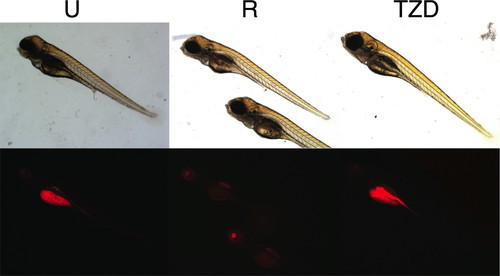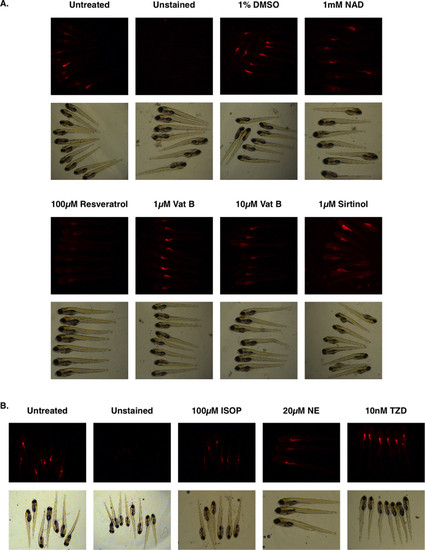- Title
-
A High Throughput Live Transparent Animal Bioassay to Identify Non-toxic Small Molecules or Genes that Regulate Vertebrate Fat Metabolism for Obesity Drug Development
- Authors
- Jones, K.S., Alimov, A.P., Rilo, H.L., Jandacek, R.P., Woollett, L.A., and Penberthy, W.T.
- Source
- Full text @ Nutr. Metab. (Lond).
|
A large portion of the yolk sac is absorbed during this sensitive developmental time window used to detect small molecule-mediated changes in fat metabolism (A). Extended incubation at 5 ng/mL nile red provides ideal signal to noise ratio for detection of anatomically localized fat stores (B). Overnight incubation was even better with the signal in the gall bladder often disappearing (shown in Fig. 4). |
|
Zebrafish respond to mammalian regulators of fat metabolism in an evolutionarily conserved manner. Similar to pharmacological application of niacin in the clinic, nicotinic acid inhibits zebrafish lipolysis (A), decreases total cholesterol (B), and increases expression of the most potent quantitative scavenger of oxidized lipids, CD36 and the classic marker of adipocyte differentiation, FABP4 (D). Zebrafish larvae were exposed to nicotinic acid (NA), nicotinamide (NAM), resveratrol (R), or resveratrol with norepinephrine (NE) from 3–7 dpf before extraction of total phospholipids for quantitation by gas chromatography (A) or quantitation of transcript levels (C and D). For cholesterol measurements zebrafish were treated with 1 mM concentrations of NA or NAM from 3–10 dpf (B). EXPRESSION / LABELING:
|
|
Pharmacology causing decreases or increases in fat metabolism is visually detectable in a quantitative fashion by using live zebrafish nile red fluorescence microscopy. Zebrafish were incubated with daily refreshing of fish water containing nile red with or without 100 μM resveratrol (R) or 10 nM troglitazone (TZD). Exposure time for all fluorescent images was set to that of untreated zebrafish (left). Bright field images are provided to show lack of overt toxicity. PHENOTYPE:
|
|
Conservation of pharmacological pathways and consistency amongst groups of animals are shown. NAD or resveratrol is known to activate SIRT-1. Conversely, sirtinol is an inhibitor of SIRT-1. Vaticanol B (Vat B) is a resveratrol tetramer natural product predicted to activate SIRT-1 as well (A). Isoproterenol or norepinephrine activation of beta-adrenergic receptors causes a decrease in detectable fat. Conversely, activation of PPARγ promotes adipocyte diferentation as predicted for treated zebrafish larvae. This slows the normal reduction in fat stores seen during this window of development. PHENOTYPE:
|
|
Antagonists of GPR142 are candidate future obesity drugs. Anti-sense knockdown of G-protein coupled receptor gene products the loss of function previously determined to cause decrease in fat content [12]. Incubation with the stable beta-adrenergic agonist isoproterenol is shown as a positive control causing increased lipolysis for comparison. PHENOTYPE:
|





